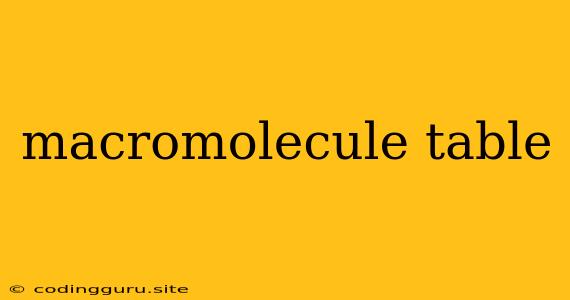Macromolecule Table: A Comprehensive Guide to the Building Blocks of Life
The world around us, from the smallest bacteria to the tallest trees, is composed of intricate and complex molecules. These molecules, known as macromolecules, are the building blocks of life, responsible for carrying out crucial functions that allow organisms to thrive. Understanding the different types of macromolecules and their unique characteristics is essential to grasping the fundamental principles of biology.
What are Macromolecules?
Macromolecules are large, complex molecules formed by the joining of smaller subunits called monomers. These monomers are linked together through a process called polymerization, forming long chains or polymers. There are four main types of macromolecules found in living organisms: carbohydrates, lipids, proteins, and nucleic acids.
The Macromolecule Table: A Visual Representation
To understand the diverse world of macromolecules, it's helpful to have a visual representation of their key characteristics. This is where a macromolecule table comes in handy. This table summarizes the main features of each macromolecule type, including:
- Monomer: The basic building block of the macromolecule.
- Polymer: The long chain formed by linking monomers.
- Function: The role of the macromolecule in living organisms.
- Examples: Specific examples of macromolecules belonging to each type.
Macromolecule Table: A Detailed Breakdown
| Macromolecule Type | Monomer | Polymer | Function | Examples | |---|---|---|---|---| | Carbohydrates | Monosaccharides (simple sugars) | Polysaccharides | Energy storage, structural support | Starch, glycogen, cellulose | | Lipids | Fatty acids and glycerol | Fats, oils, phospholipids | Energy storage, insulation, cell membrane structure | Butter, olive oil, cell membrane | | Proteins | Amino acids | Polypeptides | Structure, enzymes, transport, hormones | Muscle, enzymes, antibodies | | Nucleic Acids | Nucleotides | DNA, RNA | Genetic information storage and transmission | DNA, RNA |
Carbohydrates: The Energy Source
Carbohydrates, also known as sugars and starches, are the primary source of energy for most organisms. They are made up of monosaccharides, such as glucose and fructose. These simple sugars combine to form polysaccharides, such as starch and glycogen, which act as energy reserves. Cellulose, another important polysaccharide, provides structural support in plants.
Lipids: The Versatile Fat Family
Lipids are a diverse group of macromolecules that include fats, oils, and phospholipids. They are composed of fatty acids and glycerol. Lipids serve as a long-term energy storage source, providing insulation and cushioning for organs. Phospholipids are essential components of cell membranes, forming a barrier that controls the movement of substances into and out of the cell.
Proteins: The Workhorses of Life
Proteins are the most versatile and abundant macromolecules in living organisms. They are composed of amino acids, which are linked together to form long chains called polypeptides. Proteins have a wide range of functions, including:
- Structural support: Collagen and keratin provide structure to tissues and organs.
- Enzymes: Catalyze chemical reactions, speeding up metabolic processes.
- Transport: Hemoglobin carries oxygen throughout the body.
- Hormones: Regulate bodily functions, such as growth and development.
Nucleic Acids: The Blueprint of Life
Nucleic acids are the carriers of genetic information, responsible for storing and transmitting instructions for building and maintaining an organism. They are composed of nucleotides, which consist of a sugar, a phosphate group, and a nitrogenous base. The two main types of nucleic acids are DNA (deoxyribonucleic acid) and RNA (ribonucleic acid).
- DNA contains the genetic instructions for building and maintaining an organism.
- RNA plays a crucial role in protein synthesis, translating the genetic code into functional proteins.
Macromolecule Table: A Powerful Tool for Understanding Life
The macromolecule table provides a valuable framework for understanding the fundamental building blocks of life. By summarizing the key characteristics of each macromolecule type, it allows for easy comparison and analysis. This visual representation is essential for students and researchers alike, fostering a deeper understanding of the complex and intricate nature of biological systems.
Conclusion
The macromolecule table is an invaluable resource for anyone studying biology. It provides a concise and informative overview of the four main types of macromolecules, highlighting their building blocks, structures, functions, and examples. By understanding the unique characteristics of each macromolecule, we gain a greater appreciation for the intricate and interconnected nature of life.
